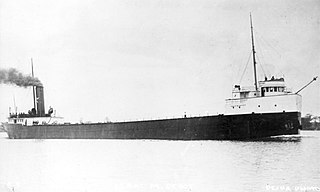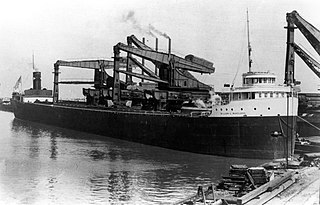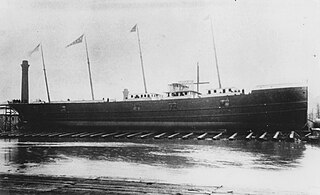
USS Essex was an Enterprise-class wooden-hulled armed naval steam sloop of war. She was built between 1874 and 1876 by Donald McKay at the Kitter Naval Yard of East Boston, Massachusetts. She was commissioned on 3 October 1876 by the United States Navy. On 23 December 1930 Essex was sold for scrap, and on 14 October 1931 she was taken to the beach just outside Duluth Harbor where they set fire to her; she eventually burned to the waterline. On 14 April 1994 the remains of Essex were listed on the National Register of Historic Places. She is significant because she is the only known remaining ship built by master shipbuilder Donald McKay.

SS Cyprus was a lake freighter that sank during a gale storm on Lake Superior on 11 October 1907. The ship went down in 460 feet of water at 46.79°N 85.60°W, in United States waters about 8 miles north of Deer Park in Luce County, Michigan. All but one of the 23 members of the crew perished.

SS Henry B. Smith was a steel-hulled lake freighter built in 1906 by the American Ship Building Company at Lorain, Ohio USA. The steamship was owned by the Acme Transit Company of Lorain, Ohio, under the management of William A. Hawgood. The hull number was 343 and the registration number was US203143.
The 1924 Lorain–Sandusky tornado was a deadly F4 tornado which struck the towns of Sandusky and Lorain, Ohio on Saturday, June 28, 1924. At least 85 people were killed by the tornado, with others killed by tornadoes that struck the northern and eastern half of the state. It is the deadliest single tornado and tornado outbreak ever recorded in Ohio history, killing more people than the more well-known 1974 Xenia tornado during the 1974 Super Outbreak and the 1985 United States-Canadian tornado outbreak respectively, both of which were F5s.

The SS Superior City was considered a pioneer vessel at her launching in 1898. She was the largest vessel ever built on freshwater at that time. She sailed the Great Lakes for twenty-two years until she sank after a collision in 1920 with the steamer Willis L. King in Whitefish Bay of Lake Superior that resulted in the loss of 29 lives. Controversy was immediate over the collision. It was subsequently ruled that the captains of both ships failed to follow the “rules-of-the-road”. Controversy started again in 1988 when the Great Lakes Shipwreck Historical Society produced a video called "Graveyard of the Great Lakes" that included extensive footage of the skeletons of the Superior City crew. The controversy continued as late as 1996 over artifacts removed from her wreck. She is now a protected shipwreck in the Whitefish Point Underwater Preserve.

SS Comet was a steamship that operated on the Great Lakes. Comet was built in 1857 as a wooden-hulled propeller-driven cargo vessel that was soon adapted to carry passengers. She suffered a series of maritime accidents prior to her final sinking in 1875 causing the loss of ten lives. She became known as the only treasure ship of Lake Superior because she carried 70 tons of Montana silver ore when she sank. The first attempts to salvage her cargo in 1876 and 1938 were unsuccessful. Comet was finally salvaged in the 1980s when the Great Lakes Shipwreck Historical Society illegally removed artifacts from the wreck. The artifacts are now the property of the State of Michigan and are on display as a loan to the Great Lakes Shipwreck Museum. The fate of her silver ore cargo is unknown. Comet's wreck is now protected by the Whitefish Point Underwater Preserve as part of an underwater museum.

The SS M.M. Drake was a wooden steam barge that towed consorts loaded with coal and iron ore on the Great Lakes. She came to the rescue of the crews of at least 4 foundering vessels in her 19 year career only to meet the same fate in her final rescue attempt. Drake sank in 1901 off Vermilion Point after a rescue attempt of her consort Michigan. Her rudder, anchor, and windlass were illegally removed from her wreck site in the 1980s. They are now the property of the State of Michigan. The rudder is on display as a loan to the Great Lakes Shipwreck Museum and the anchor and windlass are on loan for display to Whitefish Township Community Center. The wreck of Drake is protected as part of an underwater museum in the Whitefish Point Underwater Preserve.
The SS G. P. Griffith was a passenger steamer that burned and sank on Lake Erie on 17 June 1850, resulting in the loss of between 241 and 289 lives. The destruction of the G. P. Griffith was the greatest loss of life on the Great Lakes up to that point, and remains the third-greatest today, after the SS Eastland in 1915 and the Lady Elgin in 1860.

SS Isaac M. Scott was an American Great Lakes freighter that sank during the Great Lakes Storm of 1913 in Lake Huron, 6 to 7 miles northeast of Thunder Bay Island, while she was traveling from Cleveland, Ohio, United States to Milwaukee, Wisconsin, United States with a cargo of coal.

SS Clifton, originally Samuel Mather, was a whaleback lake freighter built in 1892 for service on the Great Lakes. She was 308 foot (94 m) long, 30 foot (9.1 m) beam, and 24 foot (7.3 m) depth, and had a 3,500 ton capacity. The self-propelled barge was built by the American Steel Barge Company in West Superior, Wisconsin. Her builders used a design well-suited to carry iron ore, her intended trade. The new vessel was christened Samuel Mather, after a cofounder of Pickands Mather and Company, which at the time was the second largest fleet on the Great Lakes.

SS William C. Moreland was a 600-foot (180 m) long Great Lakes freighter that ran aground on Sawtooth Reef, Lake Superior on 18 October 1910, only a month after entering service. Visibility was poor due to the smoke from several forest fires, causing the William C. Moreland to ran full steam onto a reef. There were many attempts to salvage the ship, but eventually only the 278-foot (85 m) long stern was salvaged and was used to build the 580-foot (180 m) long Sir Trevor Dawson.

The Frank C. Ball was an American Bulk carrier that was built by the Great Lakes Engineering Works of Ecorse, Michigan, for the Globe Steamship Company of Duluth, Minnesota. She was launched on December 9, 1905, as hull #14. She was powered by a 1,700 horsepower triple expansion steam engine and fueled by two coal-fired Scotch marine boilers. Even though Ball was built in 1905, she only entered service in 1906.

SS Onoko was an iron hulled Great Lakes freighter. She was launched in 1882 in Cleveland, Ohio as hull number #4, and sank on September 14, 1915 in Lake Superior near Knife River, Minnesota. Onoko is thought to be the prototype for every single steel hulled Great Lakes Bulk carrier that ever sailed. These vessels made possible the cheap transport of bulk cargoes such as iron ore, coal and limestone. Her wreckage still remains on the bottom of Lake Superior and was listed on the National Register of Historic Places in 1992.

SS D.R. Hanna was a 552-foot (168 m) long American Great Lakes freighter that operated on the Great Lakes from November 12, 1906 to her sinking on May 16, 1919 after a collision with Quincy A. Shaw. D.R. Hanna was like many other freighters, and was used to haul bulk cargoes such as iron ore, coal and grain.

The George Spencer was a wooden lake freighter that sank on along with her schooner barge Amboy on Lake Superior, near Thomasville, Cook County, Minnesota in the Mataafa Storm of 1905. On April 14, 1994, the wrecks of the Spencer and the Amboy were listed on the National Register of Historic Places.

Walk-in-the-Water was a sidewheel steamboat that played a pioneering role in steamboat navigation on the Great Lakes. She was the first such craft to run on Lake Erie, Lake Huron and Lake Michigan. Launched in 1818, she transported people and supplies to sites and points of interest around the Great Lakes, before being grounded and wrecked in a gale force storm in Buffalo's bay in 1821. According to some sources, Walk-in-the-Water's name originated from an Indian's impression of a steamboat moving ("walking") on the water with no sails.
The Morning Star was a steamship owned by the Detroit and Cleveland Navigation Company. In 1868, she sank on Lake Erie off Lorain, Ohio, after colliding with the schooner Cortland, which also sank.

SS John Mitchell was a steel-hulled, American lake freighter in service between 1907 and 1911. She was built in 1906 by the Great Lakes Engineering Works in St. Clair, Michigan, for the Cornell Steamship Company of Chicago, Illinois, which was managed by C.W. Elphicke. She entered service in 1907, and had a sister ship named William B. Davock. Throughout her career, John Mitchell carried iron ore and coal. On October 4, 1908, she ran aground at Indiana Harbor, Indiana, while loaded with iron ore.

SS Cayuga was a steel-hulled American package freighter in service between 1889 and 1895. She was built in 1889 in Cleveland, Ohio, by the Globe Iron Works Company for the Lehigh Valley Transit Company of Buffalo, New York. One of five identical sister ships, Cayuga entered service in 1889, carrying package freight between Buffalo and Chicago, Illinois, also making stops in Milwaukee, Wisconsin, and Gladstone, Michigan. Prior to her sinking, Cayuga was involved in two accidents. In the first in 1890, when she went aground in a gale just outside of Buffalo harbour; six tugboats managed to pull her free that same day. The second accident occurred in 1891, when Cayuga was involved in a collision with the package freighter Delaware near Cheboygan, Michigan.

The Erie was a steamship that operated as a passenger freighter on the Great Lakes. It caught fire and sank on August 9, 1841, resulting in the loss of an estimated 254 lives, making it one of the deadliest disasters in the history of the Great Lakes.

















